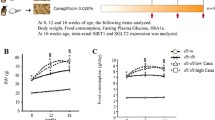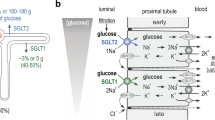Abstract
Organic anion transporter 1 (OAT1) expressed in the kidney plays an important role in the elimination of numerous anionic drugs used in the clinic. We report here that insulin, a pancreas-secreted hormone, regulated the expression and activity of kidney-specific OAT1 both in cultured cells and in rats. We showed that treatment of OAT1-expressing cells with insulin led to an increase in OAT1 expression, transport activity, and SUMOylation. Such insulin-induced increase was blocked by afuresertib, a specific inhibitor for protein kinase B (PKB), suggesting insulin regulates OAT1 through PKB signaling pathway. Furthermore, insulin stimulated transport activity and SUMOylation of endogenously expressed OAT1 in rat kidneys. In conclusion, our data support a remote sensing and signaling model, in which OAT1 plays an essential role in intercellular and inter-organ communication and in maintaining local and whole-body homeostasis. Such complex and dedicated communication is carried out by insulin, and PKB signaling and membrane sorting.
Graphical Abstract









Similar content being viewed by others
Data Availability
All data generated and analysed in this study are included in this published article.
References
Koepsell H. The SLC22 family with transporters of organic cations, anions and zwitterions. Mol Aspects Med. 2013;34(2–3):413–35.
Nigam SK. The SLC22 Transporter family: a paradigm for the impact of drug transporters on metabolic pathways, signaling, and disease. Annu Rev Pharmacol Toxicol. 2018;58:663–87.
Wang L, Sweet DH. Renal organic anion transporters (SLC22 family): expression, regulation, roles in toxicity, and impact on injury and disease. AAPS J. 2013;15(1):53–69.
Nigam SK, Bush KT, Martovetsky G, Ahn SY, Liu HC, Richard E, et al. The organic anion transporter (Oat) family: a systems biology perspective. Physiol Rev. 2015;95(1):83–123.
Xu D, You G. Loops and layers of post-translational modifications of drug transporters. Adv Drug Deliv Rev. 2017;116:37–44.
Zhang JH, Wang HX, Fan YZ, Yu Z, You GF. Regulation of organic anion transporters: Role in physiology, pathophysiology, and drug elimination. Pharmacol Therapeut. 2021;217:107647.
Huo X, Liu K. Renal organic anion transporters in drug-drug interactions and diseases. Eur J Pharm Sci. 2018;112:8–19.
Czuba LC, Hillgren KM, Swaan PW. Post-translational modifications of transporters Pharmacol Therapeut. 2018;192:88–99.
Zhang Q, Li SS, Patterson C, You GF. Lysine 48-linked polyubiquitination of organic anion transporter-1 is essential for its protein kinase C-regulated endocytosis. Mol Pharmacol. 2013;83(1):217–24.
Xu D, Wang H, You G. Posttranslational regulation of organic anion transporters by ubiquitination: known and novel. Med Res Rev. 2016;36(5):964–79.
Xu D, Zhang J, Zhang Q, Fan Y, Liu C, You G. PKC/Nedd4-2 signaling pathway regulates the cell surface expression of drug transporter hOAT1. Drug Metab Dispos. 2017;45(8):887–95.
Yu Z, Liu C, Zhang J, Liang Z, You G. Protein kinase C regulates organic anion transporter 1 through phosphorylating ubiquitin ligase Nedd4-2. BMC Mol Cell Biol. 2021;22(1):53.
Chang HM, Yeh ETH. SUMO: from bench to bedside. Physiol Rev. 2020;100(4):1599–619.
Gareau JR, Lima CD. The SUMO pathway: emerging mechanisms that shape specificity, conjugation and recognition. Nat Rev Mol Cell Biol. 2010;11(12):861–71.
Yang Y, He Y, Wang X, Liang Z, He G, Zhang P, et al. Protein SUMOylation modification and its associations with disease. Open Biol. 2017;7(10):170167.
Saitoh H, Hinchey J. Functional heterogeneity of small ubiquitin-related protein modifiers SUMO-1 versus SUMO-2/3. J Biol Chem. 2000;275(9):6252–8.
Abdulla H, Smith K, Atherton PJ, Idris I. Role of insulin in the regulation of human skeletal muscle protein synthesis and breakdown: a systematic review and meta-analysis. Diabetologia. 2016;59(1):44–55.
Guo S. Insulin signaling, resistance, and the metabolic syndrome: insights from mouse models into disease mechanisms. J Endocrinol. 2014;220(2):T1–23.
Yaribeygi H, Farrokhi FR, Butler AE, Sahebkar A. Insulin resistance: review of the underlying molecular mechanisms. J Cell Physiol. 2019;234(6):8152–61.
Baumgard LH, Hausman GJ, Fernandez MVS. Insulin: pancreatic secretion and adipocyte regulation. Domest Anim Endocrin. 2016;54:76–84.
Badal SS, Danesh FR. New insights into molecular mechanisms of diabetic kidney disease. Am J Kidney Dis. 2014;63(2):S63–83.
Reidy K, Kang HM, Hostetter T, Susztak K. Molecular mechanisms of diabetic kidney disease. J Clin Investig. 2014;124(6):2333–40.
Phatchawan A, Chutima S, Varanuj C, Anusorn L. Decreased renal organic anion transporter 3 expression in type 1 diabetic rats. Am J Med Sci. 2014;347(3):221–7.
Thongnak L, Pongchaidecha A, Jaikumkao K, Chatsudthipong V, Chattipakorn N, Lungkaphin A. The additive effects of atorvastatin and insulin on renal function and renal organic anion transporter 3 function in diabetic rats. Sci Rep. 2017;7(1):13532.
Hemmings BA, Restuccia DF. PI3K-PKB/Akt pathway. Cold Spring Harb Perspect Biol. 2012;4(9): a011189.
Tokarz VL, MacDonald PE, Klip A. The cell biology of systemic insulin function. J Cell Biol. 2018;217(7):2273–89.
Giacomini KM, Huang SM, Tweedie DJ, Benet LZ, Brouwer KLR, Chu XY, et al. Membrane transporters in drug development. Nat Rev Drug Discov. 2010;9(3):215–36.
Giacomini KM, Huang SM. Transporters in drug development and clinical pharmacology. Clin Pharmacol Ther. 2013;94(1):3–9.
Zhang J, You G. Peptide hormone insulin regulates function, expression, and SUMOylation of organic anion transporter 3. AAPS J. 2021;23(2):41.
Dantzler WH, Wright SH. The molecular and cellular physiology of basolateral organic anion transport in mammalian renal tubules. Biochim Biophys Acta. 2003;1618(2):185–93.
Villar SR, Brandoni A, Anzai N, Endou H, Torres AM. Altered expression of rat renal cortical OAT1 and OAT3 in response to bilateral ureteral obstruction. Kidney Int. 2005;68(6):2704–13.
Breljak D, Brzica H, Sweet DH, Anzai N, Sabolic I. Sex-dependent expression of Oat3 (Slc22a8) and Oat1 (Slc22a6) proteins in murine kidneys. Am J Physiol Renal Physiol. 2013;304(8):F1114–26.
Nigam AK, Li JG, Lall K, Shi D, Bush KT, Bhatnagar V, et al. Unique metabolite preferences of the drug transporters OAT1 and OAT3 analyzed by machine learning. J Biol Chem. 2020;295(7):1829–42.
Zhang JH, Yu Z, You GF. Insulin-like growth factor 1 modulates the phosphorylation, expression, and activity of organic anion transporter 3 through protein kinase A signaling pathway. Acta Pharmacol Sin B. 2020;10(1):186–94.
Lee IH, Dinudom A, Sanchez-Perez A, Kumar S, Cook DI. Akt mediates the effect of insulin on epithelial sodium channels by inhibiting Nedd4-2. J Biol Chem. 2007;282(41):29866–73.
Toyoki D, Shibata S, Kuribayashi-Okuma E, Xu N, Ishizawa K, Hosoyamada M, et al. Insulin stimulates uric acid reabsorption via regulating urate transporter 1 and ATP-binding cassette subfamily G member 2. Am J Physiol-Renal. 2017;313(3):F826–34.
Barros SA, Srimaroeng C, Perry JL, Walden R, Dembla-Rajpal N, Sweet DH, et al. Activation of protein kinase Czeta increases OAT1 (SLC22A6)- and OAT3 (SLC22A8)-mediated transport. J Biol Chem. 2009;284(5):2672–9.
Semaan DG, Igoli JO, Young L, Gray AI, Rowan EG, Marrero E. In vitro anti-diabetic effect of flavonoids and pheophytins from Allophylus cominia Sw. on the glucose uptake assays by Hep G2, L6, 3T3-L1 and fat accumulation in 3T3-L1 adipocytes. J Ethnopharmacol. 2018;216:8–17.
Wilcox G. Insulin and insulin resistance. Clin Biochem Rev. 2005;26(2):19–39.
Buppajarntham S, Junpaparp P, Salameh R, Anastasopoulou C. Insulin. 2019.
Dumble M, Crouthamel MC, Zhang SY, Schaber M, Levy D, Robell K, et al. Discovery of novel AKT inhibitors with enhanced anti-tumor effects in combination with the MEK inhibitor. PLoS ONE. 2014;9(6):e100880.
Yamaji M, Ota A, Wahiduzzaman M, Karnan S, Hyodo T, Konishi H, et al. Novel ATP-competitive Akt inhibitor afuresertib suppresses the proliferation of malignant pleural mesothelioma cells. Cancer Med. 2017;6(11):2646–59.
Chen CI, Paul H, Le LW, Wei EN, Snitzler S, Wang T, et al. A phase 2 study of ofatumumab (Arzerra((R))) in combination with a pan-AKT inhibitor (afuresertib) in previously treated patients with chronic lymphocytic leukemia (CLL). Leuk Lymphoma. 2019;60(1):92–100.
Spencer A, Yoon SS, Harrison SJ, Morris SR, Smith DA, Brigandi RA, et al. The novel AKT inhibitor afuresertib shows favorable safety, pharmacokinetics, and clinical activity in multiple myeloma. Blood. 2014;124(14):2190–5.
Kang JS, Saunier EF, Akhurst RJ, Derynck R. The type I TGF-beta receptor is covalently modified and regulated by sumoylation. Nat Cell Biol. 2008;10(6):654–64.
Plant LD, Dementieva IS, Kollewe A, Olikara S, Marks JD, Goldstein SA. One SUMO is sufficient to silence the dimeric potassium channel K2P1. Proc Natl Acad Sci U S A. 2010;107(23):10743–8.
Matic I, Schimmel J, Hendriks IA, van Santen MA, van de Rijke F, van Dam H, et al. Site-specific identification of SUMO-2 targets in cells reveals an inverted SUMOylation motif and a hydrophobic cluster SUMOylation motif. Mol Cell. 2010;39(4):641–52.
Chang CC, Tung CH, Chen CW, Tu CH, Chu YW. SUMOgo: prediction of sumoylation sites on lysines by motif screening models and the effects of various post-translational modifications. Sci Rep-UK. 2018;8(1):1–10.
Acknowledgements
We would like to thank Dr. Vanessa Routh from Rutgers University New Jersey Medical School (Newark, NJ, USA) for her guidance on rat in vivo study.
Funding
This work was supported by grants (to Dr. Guofeng You) from the National Institute of General Medical Sciences [R01-GM079123 and R01-GM097000].
Author information
Authors and Affiliations
Contributions
Zhou Yu: project design, performing experiments, data analysis, manuscript writing; Jinghui Zhang: project design, methodology establishment, supervision; Zhengxuan Liang: performing experiments, data analysis; Jingjing Wu and Kexin Liu: guidance on optimizing conditions for kidney slice preparation; Guofeng You: project design, methodology establishment, manuscript writing, supervision. All authors have approved this version of the manuscript.
Corresponding author
Ethics declarations
Conflict of Interest
The authors declare no competing interests.
Additional information
Publisher's Note
Springer Nature remains neutral with regard to jurisdictional claims in published maps and institutional affiliations.
Rights and permissions
Springer Nature or its licensor (e.g. a society or other partner) holds exclusive rights to this article under a publishing agreement with the author(s) or other rightsholder(s); author self-archiving of the accepted manuscript version of this article is solely governed by the terms of such publishing agreement and applicable law.
About this article
Cite this article
Yu, Z., Zhang, J., Liang, Z. et al. Pancreatic Hormone Insulin Modulates Organic Anion Transporter 1 in the Kidney: Regulation via Remote Sensing and Signaling Network. AAPS J 25, 13 (2023). https://doi.org/10.1208/s12248-022-00778-y
Received:
Accepted:
Published:
DOI: https://doi.org/10.1208/s12248-022-00778-y




